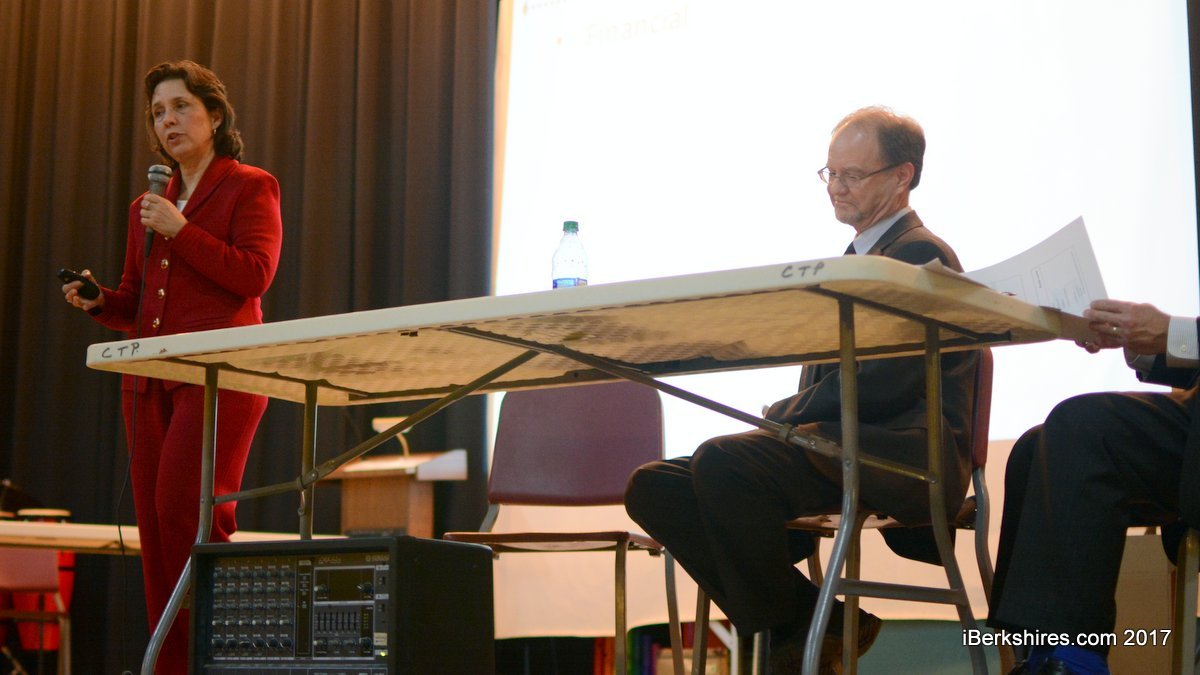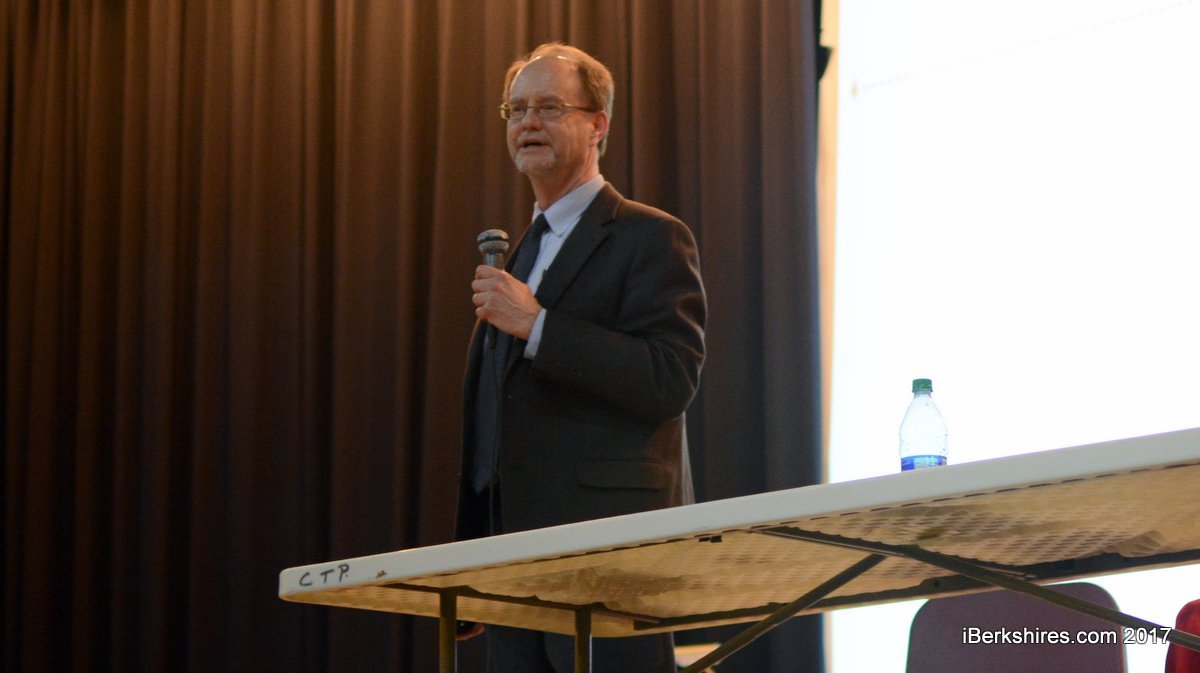
Superintendent Robert Putnam said he will hold tours of the schools to better inform the public of their condition.
ADAMS, Mass. — Adams-Cheshire school district was presented with eight possible district configurations on Wednesday.
But none offered a clear direction forward or cure-all for the district's financial and enrollment woes.
The options were provided by the University of Massachusetts' Collins Center, which was commissioned by the town of Adams to study trends and goals for the regional district and tasked with finding potential paths forward.
The center's Senior Associate Monica Lamboy led the presentation Wednesday at the C.T. Plunkett auditorium for about 100 mostly quiet residents. She gave several cost-saving scenarios that included the expected recourse of closing one of the two elementary schools to save between $376,000 and $555,000.
"The variation on alternatives is not very dramatic and there isn't one that stands out because the savings are so substantial," Lamboy said. "They are all relatively in the same ballpark, which lets you put policy and academic concerns more into the conversation."
Lamboy said the biggest savings would come from closing Plunkett in Adams and moving pre-K to third grade to Cheshire Elementary. This is anticipated to save $555,000.
Fourth and fifth-grade students would be transferred to Hoosac Valley High School, which already houses Grades 6-12.
A savings of $513,100 is anticipated if Grades 2 through 5 were moved to Cheshire Elementary and pre-K through first grade was sent to Hoosac Valley.
Lamboy said Cheshire has the nicer campus and more parking and would be optimal for a renovation project with an addition.
She noted that there will have to be some reconfiguration in the building to establish more classrooms and there would be far more students in the building than in the past. More classes would have to be held in the basement level.
Also, the building would need a major renovation if it becomes a permanent fix.
To move pre-K through third grade to Plunkett instead, would save $428,000 and to move second grade through fifth grade to Plunkett would save $376,000.
Lamboy said Plunkett has more and larger classrooms and the school currently holds roughly the number of students it would if Cheshire, with its 200 or students, were to close. Plunkett currently has about 451 students, with about 150 in Grades 4 and 5.
Plunkett has little parking, is close to a main highway and does need major repairs, but it is unknown the total extent of work that needs to be done.
Lamboy noted that having one elementary school would be an overall plus for the district because it would allow more services at the single school, correct the student-to-teacher ratio, offer more inclusion, more programming, and more access to education support and extracurricular activities.
She did say closing a school does not represent a permanent move for the district and it could always choose to renovate either one of the schools or add on to the Hoosac Valley campus in the future.
"There is the potential of a wonderful outcome from the change here and you could get the greatest building you could possibly have for your children but it takes time," she said. "New construction takes time and so does renovation and this could be an interim fix until you can come together as a community and decide what the best outcome would be."
She said the one elementary school option only works if students are moved to the recently renovated Hoosac Valley.
The first option would be to transfer eighth-graders into the high school program and relocate Grades 4 and 5 into the middle school section of Hoosac Valley.

Collins Center Senior Associate Monica Lamboy led the presentation Wednesday in the C.T. Plunkett auditorium.
The second option would also transfer the eighth-graders to the high school portion of the building and relocate pre-K through first grade in the middle school portion of the school.
Lamby said there is an early child development center in the high school that was never utilized; employing would allow Hoosac Valley to offer an early childhood development vocational program.
Also, she said students would have access to more programming at Hoosac Valley for a longer period and would be more likely to stay when they enter the high school grades. The high school has been losing students between the Grades 8 and 9 transition.
Moving more students to the high school would also allow them to fully utilize the newer building that Lamby said can hold more than 800 students. Currently, there as 624 students at the high school and they could bump it up to around 840.
The Collins Center also looked at moving the high school to Plunkett and everyone else to Hoosac Valley and splitting the district but neither were financially viable.
Lamboy said if the district were to split, the towns would have to set up three different school committees and Cheshire's allocation would increase by $800,000 just to maintain the services it has now.
"I think that this is the worst-case scenario," she said. "In addition to the cost implications, you will have continued enrollment decline and you still have to maintain aging buildings without a partner."
Collins Center representative Frederick "Rick" Kingsley also presented some best practice cost-saving recommendations that could save the district upwards of $905,000 and near $350,000 in reinvestment.
He said the big ticket would be for the district to shift all current employees and retirees from the Berkshire Health Group to the Massachusetts Group Insurance Commission.
He noted recipients would have deductibles and co-pays but it would save the district $750,000. He also recommended transferring the pension system from the town of Adams to a different system with a better rate.
Kingsley urged the district to smooth out its pay scales. He said there are huge increases, some 8 or 9 percent, built into step increases that can be spread out more equally through a contract.
He also suggested they reduce the value and number of stipends and create a nepotism policy because many residents aired concern about nepotism in the district.
Kingsley said it would also be beneficial to improve communication with the faculty, students, and community and create a feasibility study committee to study what the district needs in an elementary school.
Collins Center representative William Lupini presented some educational changes that could save the district in the long run.
He said a lot of cuts, especially to special education, education specialists, and paraprofessionals, may have cost the district more in the long run.

Collins Center representative Frederick 'Rick' Kingsley offered some financial changes the district could make.
"What happens in a number of districts is decisions get made in very tough budget times that seem very logical but they actually contribute to extending the problems," he said.
He said the district may see cost decreases if it lowers special-education enrollment and Individualized Education Programs.
Lupini recommended bringing back classroom support and putting a paraprofessional in every first grade and kindergarten classroom creating a special education team to better manage referrals and IEPs
"We take a very specialized job that controls money and instead of putting it in the hands of five or six people we put it in the hands of 20," he said. "Then we don't train them because there are too many and our costs go."
He added that the district should increase professional learning and increase the professional development budget but ask educators to take courses that align with districtwide focuses.
He said hiring more specialists and paraprofessionals would allow more intervention and special help to all students. He added that many students on IEPs just need services that should be present in regular education provided by specialists.
He also suggested finding ways to attract more students and expanding programming. He recommended teaming up with McCann Technical School and offering vocational programming at Hoosac Valley.
Because the School Committee plans to vote on the district's budget in March, Superintendent Robert Putnam will hold tours of the school buildings to better inform the public and town officials of their condition as well as provide scenarios for reorganizing the district into two schools.
There will be a tour for town officials on Saturday and tours open to the public Feb. 14 through the 16. The meetings will begin at 5:30 at Cheshire Elementary School and continue to C.T. Plunkett.
The School Committee will ultimately make the decision, however, and has noted it plans to hold public input meetings before making a ruling.







